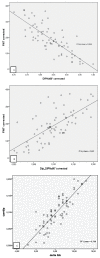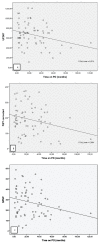Two-in-one protocol: simultaneous small-pore and ultrasmall-pore peritoneal transport quantification
- PMID: 22383631
- PMCID: PMC3524870
- DOI: 10.3747/pdi.2011.00175
Two-in-one protocol: simultaneous small-pore and ultrasmall-pore peritoneal transport quantification
Abstract
Background: Reduced free water transport (FWT) through ultrasmall pores contributes to net ultrafiltration failure (UFF) and should be seen as a sign of more severe functional deterioration of the peritoneal membrane. The modified peritoneal equilibration test (PET), measuring the dip in dialysate Na concentration, estimates only FWT. Our aim was to simultaneously quantify small-solute transport, FWT, and small-pore ultrafiltration (SPUF) during a single PET procedure.
Methods: We performed a 4-hour, 3.86% glucose PET, with additional measurement of ultrafiltration (UF) at 60 minutes, in 70 peritoneal dialysis patients (mean age: 50 ± 16 years; 61% women; PD vintage: 26 ± 23 months). We calculated the dialysate-to-plasma ratios (D/P) of creatinine and Na at 0 and 60 minutes, and the Na dip (Dip(D/PNa60')), the delta dialysate Na 0-60 (ΔDNa(0-60)), FWT, and SPUF.
Results: Sodium sieving (as measured by ΔDNa(0-60)) correlated strongly with the corrected Dip(D/PNa60') (r = 0.85, p < 0.0001) and the corrected FWT (r = 0.41, p = 0.005). Total UF showed better correlation with FWT than with indirect measurements of Na sieving (r = 0.46, p < 0.0001 for FWT; r = 0.360, p < 0.0001 for Dip(D/PNa60')). Corrected FWT fraction was 0.45 ± 0.16. A negative correlation was found between time on PD and both total UF and FWT (r = -0.253, p = 0.035 and r = -0.272, p = 0.023 respectively). The 11 patients (15.7%) diagnosed with UFF had lower FWT (89 mL vs 164 mL, p < 0.05) and higher D/P creatinine (0.75 vs 0.70, p < 0.05) than did the group with normal UF. The SPUF correlated positively with FWT in the normal UF group, but negatively in UFF patients (r = -0.709, p = 0.015). Among UFF patients on PD for a longer period, 44.4% had a FWT percentage below 45%.
Conclusions: Measurement of FWT and SPUF is feasible by simultaneous quantification during a modified 3.86% glucose PET, and FWT is a decisive parameter for detecting causes of UFF in addition to increased effective capillary surface.
Figures



Similar articles
-
The mini-PET in pediatric peritoneal dialysis: a useful tool to predict volume overload?Pediatr Nephrol. 2013 Jul;28(7):1121-6. doi: 10.1007/s00467-013-2447-2. Epub 2013 Mar 15. Pediatr Nephrol. 2013. PMID: 23494552
-
Hepatocyte growth factor signalizes peritoneal membrane failure in peritoneal dialysis.BMC Nephrol. 2014 Dec 17;15:201. doi: 10.1186/1471-2369-15-201. BMC Nephrol. 2014. PMID: 25519900 Free PMC article.
-
Analysis of Ultrafiltration Failure Diagnosed at the Initiation of Peritoneal Dialysis with the Help of Peritoneal Equilibration Tests with Complete Drainage at Sixty Minutes. A Longitudinal Study.Perit Dial Int. 2016 Jul-Aug;36(4):442-7. doi: 10.3747/pdi.2015.00163. Epub 2016 Jan 13. Perit Dial Int. 2016. PMID: 26764342 Free PMC article.
-
Ultrafiltration Failure Is a Reflection of Peritoneal Alterations in Patients Treated With Peritoneal Dialysis.Front Physiol. 2018 Dec 20;9:1815. doi: 10.3389/fphys.2018.01815. eCollection 2018. Front Physiol. 2018. PMID: 30618825 Free PMC article. Review.
-
Update on mechanisms of ultrafiltration failure.Perit Dial Int. 2009 Feb;29 Suppl 2:S123-7. Perit Dial Int. 2009. PMID: 19270200 Review.
Cited by
-
The mini-PET in pediatric peritoneal dialysis: a useful tool to predict volume overload?Pediatr Nephrol. 2013 Jul;28(7):1121-6. doi: 10.1007/s00467-013-2447-2. Epub 2013 Mar 15. Pediatr Nephrol. 2013. PMID: 23494552
-
Hepatocyte growth factor signalizes peritoneal membrane failure in peritoneal dialysis.BMC Nephrol. 2014 Dec 17;15:201. doi: 10.1186/1471-2369-15-201. BMC Nephrol. 2014. PMID: 25519900 Free PMC article.
-
AQP1-Containing Exosomes in Peritoneal Dialysis Effluent As Biomarker of Dialysis Efficiency.Cells. 2019 Apr 9;8(4):330. doi: 10.3390/cells8040330. Cells. 2019. PMID: 30970608 Free PMC article.
-
Insulin Resistance in Nondiabetic Peritoneal Dialysis Patients: Associations with Body Composition, Peritoneal Transport, and Peritoneal Glucose Absorption.Clin J Am Soc Nephrol. 2015 Dec 7;10(12):2205-12. doi: 10.2215/CJN.03170315. Epub 2015 Oct 27. Clin J Am Soc Nephrol. 2015. PMID: 26507143 Free PMC article.
-
Survival of Peritoneal Membrane Function on Biocompatible Dialysis Solutions in a Peritoneal Dialysis Cohort Assessed by a Novel Test.J Clin Med. 2021 Aug 18;10(16):3650. doi: 10.3390/jcm10163650. J Clin Med. 2021. PMID: 34441945 Free PMC article.
References
-
- Heimbürger O, Waniewski J, Werynski A, Tranæus A, Lindholm B. Peritoneal transport in CAPD patients with permanent loss of ultrafiltration capacity. Kidney Int 1990; 38:495–506 - PubMed
-
- Krediet RT, Imholz AL, Struijk DG, Koomen GC, Arisz L. Ultrafiltration failure in continuous ambulatory peritoneal dialysis. Perit Dial Int 1993; 13(Suppl 2):S59–66 - PubMed
-
- Selgas R, Bajo MA, Castro MJ, del Peso G, Aguilera A, Fernández-Perpén A, et al. Risk factors responsible for ultrafiltration failure in early stages of peritoneal dialysis. Perit Dial Int 2000; 20:631–6 - PubMed
-
- Monquil MC, Imholz AL, Struijk DG, Krediet RT. Does impaired transcellular water transport contribute to net ultrafiltration failure during CAPD? Perit Dial Int 1995; 15:42–8 - PubMed
-
- Ho-dac-Pannekeet MM, Atasever B, Struijk DG, Krediet RT. Analysis of ultrafiltration failure in peritoneal dialysis patients by means of standard peritoneal permeability analysis. Perit Dial Int 1997; 17:144–50 - PubMed
Publication types
MeSH terms
Substances
LinkOut - more resources
Full Text Sources

